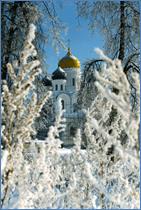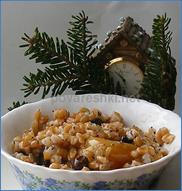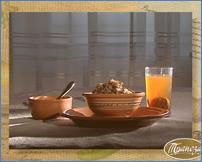
Методическая разработка внеклассного мероприятия
по английскому языку
«Sochelnik (Christmas Eve)»
Михайлов М.А., учитель английского языка
МКОУ «Подлесненская ОШ»
New words: The Russian Orthodox Church - Русская православная церковь; official holiday – официальный праздник; Christmas Fast - Рождественский пост; Christmas Eve - сочельник, канун Рождества; believer - религ. Верующий
The beginning:
1.1. Do you like holidays?
1.2. Do you know that many people celebrate the religious holidays? What orthodox religious holidays believers celebrate in our country?
1.3. Read the text below. Name two of the largest holidays in Orthodox Church.
 In Russia, Christmas is annually celebrated on January 7th, thanks to the
Russian Orthodox Church that has made it an official holiday in the country.
The Russian Orthodox Church is more than one thousand years old and most of the
Christian population in the country belongs to it. In Russia the Christmas
Eve is called Sochelnik, or Kolyada. It is the last day of
Christmas Fast that lasts for 40 days. This means that the believers observing
this fast don’t eat meat, eggs and dairy products during this period, go to
church more often than usual, thus preparing themselves for the second largest
holiday in Orthodox Church – Christmas (Easter is considered to be the most
important one).
In Russia, Christmas is annually celebrated on January 7th, thanks to the
Russian Orthodox Church that has made it an official holiday in the country.
The Russian Orthodox Church is more than one thousand years old and most of the
Christian population in the country belongs to it. In Russia the Christmas
Eve is called Sochelnik, or Kolyada. It is the last day of
Christmas Fast that lasts for 40 days. This means that the believers observing
this fast don’t eat meat, eggs and dairy products during this period, go to
church more often than usual, thus preparing themselves for the second largest
holiday in Orthodox Church – Christmas (Easter is considered to be the most
important one).
1.4. Is Christmas an official holiday in our country?
1.5. What are the synonyms of the Christmas Eve in Russia?
1.6. What does the word Fast mean?
New words: Star of Bethlehem (вифлеемская звезда) - the Bible says that when Christ was born a bright star appeared above Bethlehem. The star on top of Christmas trees now represents the Star of Bethlehem; eight-angle star – восьмиугольная звезда; tablecloths – скатерть; rug - ковёр.
1.7.  Look at the picture. What are the children doing?
Look at the picture. What are the children doing?
1.8. Do you help to decorate a Christmas tree?
1.9. Read the text below
Before Christmas Eve, people clean and tidy their house and yard, and decorate the house in a lavish manner (щедро). Beautiful decorations, tablecloths, napkins, and rugs are used to create a festive atmosphere. A Christmas tree is also common - sometimes adorned with foods due to the high cost of decorations. On the top of it there is an eight-angle star, symbolizing the star of Bethlehem.
1.10. What decoration do you use to create a festive atmosphere at home before Christmas Eve?
1.11. How do you like to help your mother to prepare a holiday dinner?
1.12. What is your favourite holiday food?
1.13. Have you ever heard about special Christmas feast?
1.14. What are traditional Russian Christmas dishes? List as many as you can remember. Compare your list with that of your partner. Now read the text and complete your lists.
 Sochelnik
is considered to be a family dinner. In the days of old the Christmas table was
strewed with hay and then only covered with a tablecloth. Twelve dishes
(according to the number of the Apostles) were put in the centre of the table.
Apart from sochivo the feast would offer pancakes, fish, fish and meat jelly, roast
young pork with porridge, honey cakes, vzvars, etc., depending on what the
family could afford.
Sochelnik
is considered to be a family dinner. In the days of old the Christmas table was
strewed with hay and then only covered with a tablecloth. Twelve dishes
(according to the number of the Apostles) were put in the centre of the table.
Apart from sochivo the feast would offer pancakes, fish, fish and meat jelly, roast
young pork with porridge, honey cakes, vzvars, etc., depending on what the
family could afford.
Nowadays the menu usually depends on the wealth of the families. A typical Christmas dinner however, includes delicacies such as hot roast Pirog (Russian pies made out of meat, fish, mushrooms, potatoes or cabbage), and Pelmeni (meat dumplings).
Sochelnik is the day of rigorous fast (строгий пост). On this day there is a long-hour church service (продолжительная церковная служба), which begins with the so called ‘Tsarskie Chasy’ (царские часы) or the Royal Hours. The Russian Tsar and his family used to attend this kind of solemn (торжественной, священной) service, including reading of psalms (псалмы) and prayers (молитвы), so it got its name. On the whole, the service is very long and after you have attended it, you may eat a little. That is why there is a saying that you can’t eat anything on Christmas Eve, until the first star has appeared in the sky.
 People then eat 'sochivo'. It is made of boiled grains of wheat, barley or rice
mixed with raisings, honey and almond or poppy milk. The Russian word for
Christmas Eve ‘sochelnik’ comes from the word 'sochivo'. (the grains symbolize
hope and immortality), and honey, raisings and poppy seeds remember of the
sweet life everlasting. The ‘sochivo’ is eaten from a common dish to symbolize
unity.
People then eat 'sochivo'. It is made of boiled grains of wheat, barley or rice
mixed with raisings, honey and almond or poppy milk. The Russian word for
Christmas Eve ‘sochelnik’ comes from the word 'sochivo'. (the grains symbolize
hope and immortality), and honey, raisings and poppy seeds remember of the
sweet life everlasting. The ‘sochivo’ is eaten from a common dish to symbolize
unity.

The other main dish is vzvar, of apples, pears, plums, raisins, cherries and other fruits boiled in water. Vzvar has symbolical meaning. It is cooked to celebrate the birth of a child.
 Kolyadki,
or kalitki, are small pastries made of fresh rye dough with various fillings,
fruit liqueurs, brushings or bakings. Fresh rye dough is rolled out into a thin
5mm layer and cut into squares. The edges are bent up, and the corners are
pinched to make a flat box. It is filled with various fillings and baked. The
name derives from Kolyad – an ancient pagan holiday that later merged with
Christmas.
Kolyadki,
or kalitki, are small pastries made of fresh rye dough with various fillings,
fruit liqueurs, brushings or bakings. Fresh rye dough is rolled out into a thin
5mm layer and cut into squares. The edges are bent up, and the corners are
pinched to make a flat box. It is filled with various fillings and baked. The
name derives from Kolyad – an ancient pagan holiday that later merged with
Christmas.
Like the words of colloquial (разговорной) speech get borrowed (заимствованный), the original national cuisine or individual dishes penetrate (входит) into other cuisines, if they are especially enjoyed. That is what happened to kolyadki.
 It is now common practice, especially in little Russian towns and villages,
for groups of masquerading children having self-made Bethlem stars in their
hands, to travel from house to house singing songs known as ‘kolyadki’.
Kolyadki are pastoral carols to the baby Jesus. In return for their songs, the
singers called ‘kolyadovshchiki’ are offered chocolates, sweets and coins,
which they gladly accept before moving on to the next home. This happens on
Christmas Day and some days afterwards.
It is now common practice, especially in little Russian towns and villages,
for groups of masquerading children having self-made Bethlem stars in their
hands, to travel from house to house singing songs known as ‘kolyadki’.
Kolyadki are pastoral carols to the baby Jesus. In return for their songs, the
singers called ‘kolyadovshchiki’ are offered chocolates, sweets and coins,
which they gladly accept before moving on to the next home. This happens on
Christmas Day and some days afterwards.
Finish the sentences:
1) Sochelnik is considered to be …
2) Apart from sochivo the feast would offer …
3) A typical Christmas dinner however, includes …
4) Sochelnik is the day of …
5) The Russian word for Christmas Eve ‘sochelnik’ comes from the word …
6) The other main dish is vzvar, of ….
7) Kolyadki, or kalitki, are small pastries made of …
8) The name derives from Kolyad …
9) It is now common practice, especially in little Russian towns and villages, for groups of masquerading children having self-made Bethlem stars in their hands, …
10) This magnificent original dish is …
Choose the right answer
1) … dishes were put in the centre of the table in the days of old the Christmas. a) ten; b) twelve.
2) There is a saying that you … eat anything on Christmas Eve, until the first star has appeared in the sky a) can’t b) can
3) The ‘sochivo’ is eaten from a common dish a) to symbolize unity; b) celebrate the birth of a child.
4) Kolyadki, or kalitki, are a) are small pastries made of fresh rye dough; b) pastoral carols to the baby Jesus
5) Kolyadki, or kalitki, are small pastries made of fresh a) rye dough; b) wheat dough
Ссылки:
http://www.theholidayspot.com/christmas/worldxmas/russia.htm
http://www.russian-language-for-lovers.com/russian-christmas.html
http://www.whychristmas.com/cultures/russia.shtml
http://en.restoran.ru/msk/news/masterclass_or_study/kolyadki
http://www.travelcentre.com.au/travel/russia/russian_christmas.htm
http://www.russia-ic.com/culture_art/traditions/645/
http://ana-sm.ru/2008/01/05/sochelnik.html
http://www.otvetin.ru/page/365/
http://rus.glas.org.ua/projects/trapeza/kutya.html
www.start.crimea.ua
http://www.photographer.ru/events/afisha/1090.htm
http://adalin.mospsy.ru/ny/eligr.shtml
http://www.wild-mistress.ru/wm/wm.nsf/publicall/2008-10-31-83745.html
Скачано с www.znanio.ru
Материалы на данной страницы взяты из открытых источников либо размещены пользователем в соответствии с договором-офертой сайта. Вы можете сообщить о нарушении.